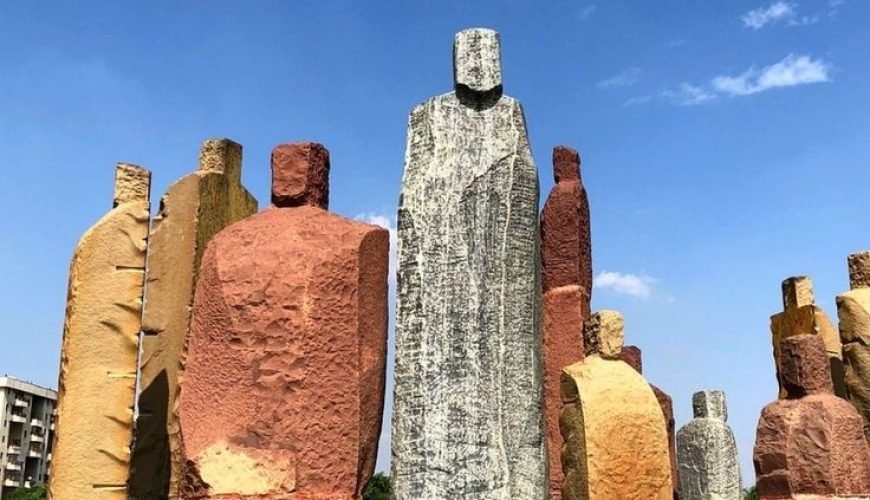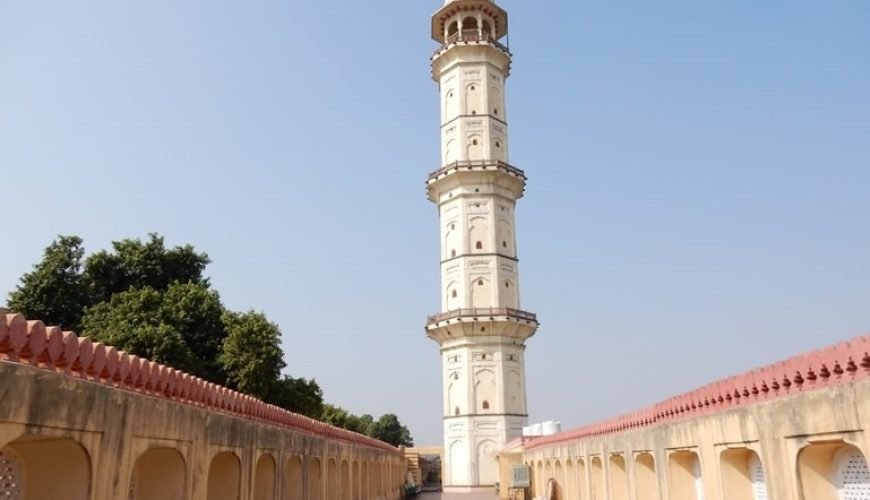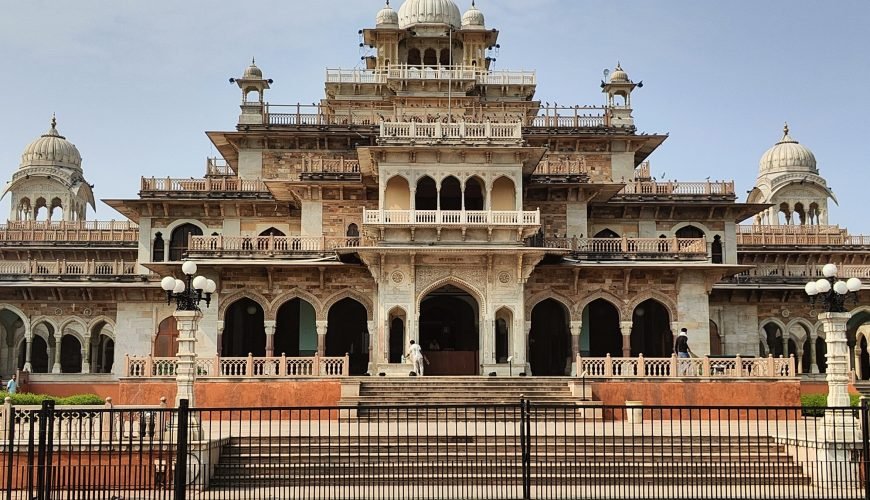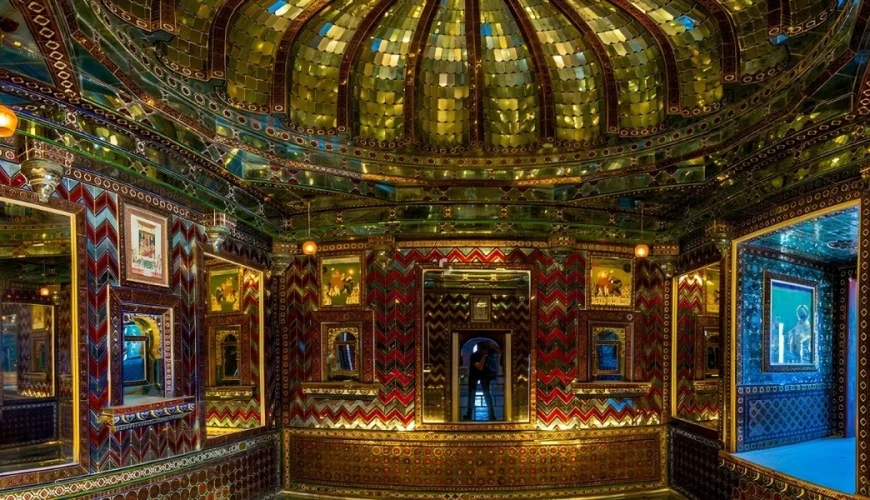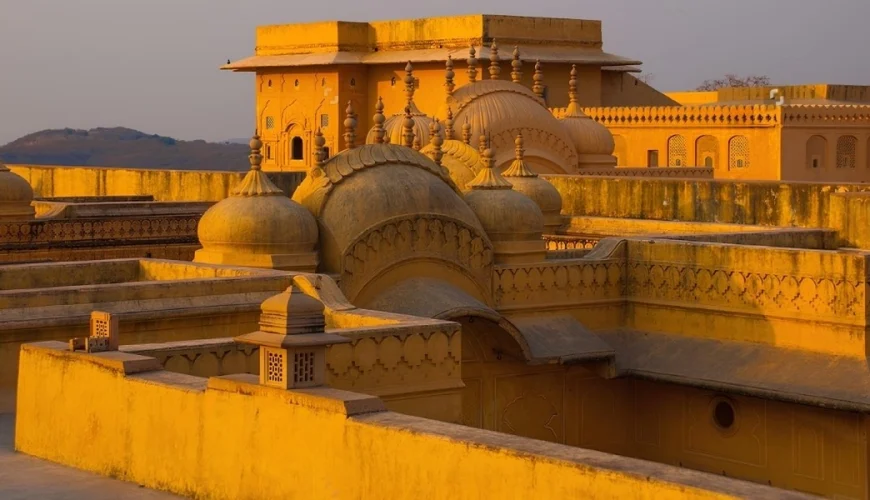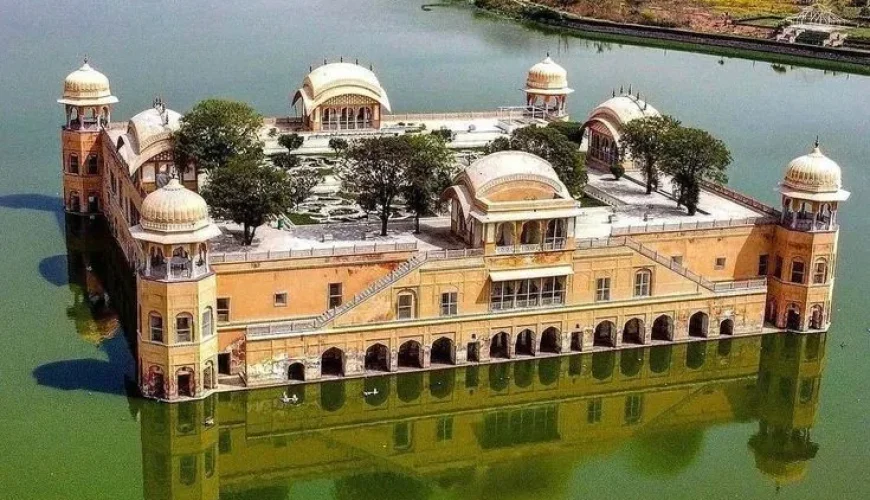Central Park Jaipur: The Largest Park in the Pink City
Built in 2006, Jaipur Central Park is the biggest park in the city. It has the longest jogging path and a special walking track. The Jaipur Development Authority made the park, and it’s a green space right in the center of the city with four gates. The park was opened on January 21, 2006, by Rajasthan’s Chief Minister at the time, Srimati Vasundhara Raje Scindia. Centrak Park Jaipur Bird-Watching Fun: If you like watching birds, Central Park is a great place. Many birds, both local and migratory, live in the park, so it’s perfect for bird watchers. Musical Fountain and Sculptures: There is a big musical fountain that lights up when the sun sets. It’s a fun attraction for visitors. The park also has some cool stone sculptures that you can see while you’re walking around. The fountain’s lights make the park look magical at night. Exercise and Relaxation: The jogging track is 5 kilometers long, and many people use it for running or walking. The park also offers yoga sessions in the early morning. It’s a nice place to get fit or just have fun with your family. Giant National Flag: One of the coolest things in the park is the giant national flagpole. It’s 206 feet tall, making it the tallest flagpole in India. The flag is huge, and it looks amazing when it’s lit up at night. Capricornus Statues: The park has 13 stone statues that look like hedges but are arranged to represent the Capricornus constellation. They are really interesting, and many people take photos of them. Park Facilities: Central Park has restrooms and clean drinking water, so it’s comfortable for everyone to visit. It’s a great spot for picnics and relaxing with family. Location: Central Park is close to Rambagh Golf Club and Polo Ground, right in the middle of the Pink City, next to Statue Circle, and near S. M. S. Hospital. Places to Eat Nearby: There are lots of restaurants around Central Park where you can eat tasty Rajasthani food or continental dishes. Some good places to try are Polo Bar, Rajput Room, Rajasthani Thali, Little Italy, and The Grill. If you love coffee, visit Saras Point at Statue Circle for a great coffee experience. Park Hours and Fees: Central Park is open every day from 5:00 AM to 9:00 PM, and it’s free to enter. Nearby Attractions: How to Get There: Central Park is easy to reach from anywhere in the city. You can take a taxi, auto autorickshaw, or bus. The nearest bus stop is Ashok Nagar Bus Stop. Jaipur is full of fun things to do and see. For a great adventure, you can book a tour package from Kingsland Holiday. Whether you’re exploring historic sites, enjoying yummy food, or relaxing in Central Park, you’ll have a fantastic time in the Pink City!
Explore Sargasuli Tower: Jaipur’s Majestic Victory Monument
The Sargasuli Tower, also known as Isar Lat, is a tall and special tower in Jaipur, built in 1749. It was made to celebrate Maharaja Sawai Ishwari Singh’s big win in a battle called the Battle of Rajmahal. Maharaja Ishwari Singh was the eldest son of Maharaja Sawai Jai Singh II, who started Jaipur. The tower’s design was inspired by two famous towers: the Qutub Minar and the Kirti Stambh of Chittorgarh. Maharaja Ishwari Singh liked their designs and wanted something similar for Jaipur. Where Is It? Sargasuli Tower is in the Aatish Market, at the corner of Tripolia Bazar and Gangori Bazar, near Choti Chaupar Chowk and Tripolia Gate. It’s right in the middle of the city, so it’s easy to find. History of Sargasuli Tower The tower was built by Maharaja Sawai Ishwari Singh to celebrate his victory in the 1747 Battle of Rajmahal. This battle was between Ishwari Singh and his half-brother, Sawai Madho Singh, who both wanted to be king. Maharaja Sawai Jai Singh II, the founder of Jaipur, had two wives. His first wife, Maharani Chandar Kanwar Ji, and his second wife, a princess from Mewar. He made a promise that his first wife’s son would be the next king, even if he had other sons later. When Maharaja Jai Singh II died, Ishwari Singh became king as per tradition, but this upset Madho Singh, who thought he should be king instead. The Battle of Rajmahal To settle the argument, they agreed to meet for peace talks in 1744. Madho Singh was given some land but faced trouble from other groups. Ishwari Singh used this chance to go back to Jaipur, and Madho Singh decided to fight. The Battle of Rajmahal took place in 1747. Madho Singh’s army fought against Ishwari Singh’s army led by General Narayandas. Madho Singh lost and had to run away. To celebrate his victory, Ishwari Singh built Sargasuli, the tallest tower in Jaipur. It was named Isar Lat, which means ‘Passage to Heaven’. What Does the Tower Look Like? The Sargasuli Tower is 140 feet tall and was designed by a craftsman named Ganesh Khowan. It has seven floors and is built in a mix of Mughal and Rajput styles, painted yellow to stand out against Jaipur’s pink buildings. The tower has 264 steps leading to the top, where you can see many important landmarks in Jaipur, like Nahargarh Fort, Hawa Mahal, and the City Palace. Each floor has balconies and windows to enjoy the view. The tower was also used to keep watch for any dangers and alert the people of Jaipur. Visiting Sargasuli Tower When to Visit: The tower is open every day from 9:30 AM to 4:00 PM. The entry fee is INR 70 for everyone. Nearby Places to Visit: How to Get There: Sargasuli Tower is easy to reach. You can take a cab, taxi, autorickshaw, or e-rickshaw. The nearest bus stop is Choti Chaupar, and it’s about 5 kilometers from Jaipur Junction Railway Station. The nearest airport is Jaipur International Airport. Extra Tips: If you want a fun trip to Jaipur, consider booking a tour with us. Kingsland Holiday can help you explore all the amazing sights in the city. To find out more, just fill out our Contact Us form.
Albert Hall Museum Jaipur Ticket: A Comprehensive Guide
Nestled in the heart of Jaipur, the Albert Hall Museum Jaipur stands as a testament to the city’s rich cultural and historical heritage. As the oldest museum in Rajasthan, it offers a fascinating glimpse into India’s past through its extensive collection of artifacts and its stunning Indo-Saracenic architecture. Key Takeaways History of Albert Hall Museum The foundation of the **Albert Hall Museum** was laid in 1876 during the visit of Prince Albert Edward to Jaipur. Initially envisioned as a concert hall, the building’s purpose evolved into a museum, thanks to the vision of Maharaja Sawai Madho Singh II and the architectural prowess of Samuel Swinton Jacob. Completed in 1887, the museum houses a collection of artifacts from India and around the world. Architectural Significance Albert Hall Museum is a prime example of **Indo-Saracenic architecture**. Its intricate design includes domes, arches, and minarets inspired by Islamic, Persian, and Indian styles. The museum’s façade, constructed from sandstone, is particularly mesmerizing at night when it is illuminated, casting a golden glow. Galleries and Exhibits The museum boasts 16 galleries, each with its unique collection: Special Exhibits and Events The Albert Hall Museum frequently hosts special exhibits and cultural events that showcase various aspects of Indian art and history. These events attract scholars, artists, and tourists from around the world, enhancing the museum’s reputation as a cultural hub. Albert Hall Museum Jaipur Ticket Information Ticket Prices: Category Indian Citizens Foreign Citizens Adults ₹40 ₹300 Students ₹20 ₹150 Composite Ticket (Including other monuments) ₹300 ₹1,000 Night Visit Entry Fees: Category Indian Citizens Foreign Citizens Adults ₹100 ₹100 Special Days with Free Entry: Audio Guides and Educational Tours For those keen on a more immersive experience, the museum offers audio guides in multiple languages. These guides provide detailed information about the exhibits and the history of the museum. Additionally, educational tours are available for school groups and tourists, led by knowledgeable guides. Educational Tour Options: Type Duration Cost Self-Guided Tour Flexible Free Audio Guide 2 hours ₹150 Guided Tour 1 hour ₹500 (Group) Visiting Hours and Best Time to Visit of albert Hall Night Visit Experience Visiting the museum at night offers a different perspective. The illuminated structure against the night sky is a visual treat. The night visit entry fee is ₹100 for both Indian and foreign visitors, making it an affordable experience for all. The best time to visit is during the cooler months, from October to March, to avoid the extreme summer heat. Facilities and Accessibility The museum provides several amenities to enhance visitor experience: Online and Offline Ticket Booking How to Book Tickets Online Booking tickets online for the Albert Hall Museum is straightforward and follow the steps to secure your entry. Photography and Videography Photography is allowed inside the museum, but flash photography is prohibited to protect the artifacts. The museum offers numerous photogenic spots, particularly the illuminated exterior at night. How to Reach Albert Hall Museum Location: Ram Niwas Garden, Jaipur, Rajasthan. Transportation Options: Nearby Attractions After visiting the Albert Hall Museum, explore other nearby attractions: Cafeteria and Souvenir Shop After exploring the museum, visitors can relax at the on-site cafeteria, which offers a variety of snacks and beverages. The museum’s souvenir shop is the perfect place to purchase mementos and gifts, including replicas of famous artifacts and local handicrafts. for more click here Visitor Experiences Visitors often praise the Albert Hall Museum for its well-preserved exhibits and informative displays. The nighttime illumination of the museum is particularly popular, creating a magical atmosphere that enhances the architectural beauty of the building. Check our Exciting offers of jaipur – https://kingslandholiday.com/rajasthan-tour-packages/jaipur/ For More informations- https://kingslandholiday.com/
Sheesh Mahal Jaipur | History, Timings, Entry Tickets
Sheesh Mahal Jaipur, or the “Palace of Mirrors,” is one of the most enchanting structures within the Amber Fort complex in Jaipur. Known for its intricate mirror work and stunning architecture, Sheesh Mahal attracts thousands of tourists each year who come to marvel at its beauty and historical significance. Key Takeaways: History of Sheesh Mahal, Jaipur Sheesh Mahal was constructed in the early 18th century by Maharaja Jai Singh. This architectural marvel was designed to provide the queen with a view of the twinkling stars while she slept, as she was not permitted to sleep in the open air. The mirrors were strategically placed to create an illusion of a starry night with just a few lit candles. Architecture and Design The architecture of Sheesh Mahal is a testament to the exquisite craftsmanship of the artisans of that era. The walls and ceilings are adorned with intricate mirror work and mosaics. Each piece of mirror is hand-cut and meticulously placed to create elaborate patterns that reflect light beautifully. Key Features: Historical Significance Sheesh Mahal was built during a time when Rajasthan was flourishing under the rule of its Maharajas. It served not only as a royal residence but also as a testament to the opulence and artistic vision of the time. The palace’s mirrors were imported from Belgium, showcasing the international trade links of the era. Unique Experiences at Sheesh Mahal, Jaipur Visitors to Sheesh Mahal can experience a light and sound show in the evening, which narrates the history of Amber Fort and Sheesh Mahal. The play of lights on the mirror work during the show is a sight to behold. Table: Unique Experiences Experience Description Light and Sound Show Evening show narrating the history of the fort Photography Sessions Best spots for photography within Sheesh Mahal Guided Historical Tours Detailed tours explaining the significance Conservation Efforts Sheesh Mahal has undergone several restoration projects to preserve its grandeur. Efforts by local authorities and NGOs have been crucial in maintaining the site and ensuring that future generations can also experience its beauty. [Rajasthan Tourism Official Website](https://www.tourism.rajasthan.gov.in/) Significance in Culture and Tourism Sheesh Mahal holds a special place in Rajasthan’s culture and history. It has also been featured in various Bollywood movies, making it a popular destination for film enthusiasts. The palace’s unique mirror work and historical significance make it a must-visit spot for tourists. Visiting Sheesh Mahal, Jaipur Visitors can reach Sheesh Mahal via various modes of transport. The nearest bus stand is Amer Fort bus stand, and it is well-connected by local taxis and cabs. The best time to visit is during the cooler months from October to March. Entry fees are nominal, and the Mahal is open from 9:00 AM to 6:00 PM. Table: Entry Fees and Timings Category Fees Timings Indian Adults INR 100 9:00 AM – 6:00 PM Foreign Tourists INR 200 9:00 AM – 6:00 PM Students INR 50 9:00 AM – 6:00 PM Exploring Sheesh Mahal,Jaipur The key highlights within Sheesh Mahal include the beautiful mirror mosaics, the intricate frescoes, and the stunning carvings on the walls and ceilings. Guided tours are available and highly recommended to gain a deeper understanding of the history and significance of the palace. Nearby Attractions of Sheesh Mahal Jaipur While visiting Sheesh Mahal, tourists can also explore other attractions within Amber Fort, such as the Diwan-e-Aam (Hall of Public Audience), the Sukh Niwas, and the Amber Palace. These sites offer a comprehensive view of the grandeur of Rajasthan’s royal heritage. [Jaipur Sightseeing Tours](https://kingslandholiday.com/rajasthan-tour-packages/jaipur/) Dining and Accommodation Near Palaces for mirrors There are several dining options near Amber Fort, ranging from street food vendors to high-end restaurants. For accommodation, visitors can choose from luxury hotels to budget stays, all offering excellent hospitality. Photography Tips ( Guideline for Sheesh Mahal) Check our exclusive discounts on https://kingslandholiday.com/rajasthan-tour-packages FAQs
Nahargarh Fort Ticket Price: A Comprehensive Guide
Nahargarh Fort, perched majestically on the rugged hills of the Aravalli range, offers a captivating glimpse into Rajasthan’s rich history. Originally built by Maharaja Sawai Jai Singh II in the 18th century, this fort has witnessed numerous historical events and continues to attract tourists from around the world. Key Takeaways: Nahargarh Fort Ticket Price Visiting Nahargarh Fort requires purchasing a ticket, with prices structured to accommodate both local and international visitors. Below is a detailed breakdown of the ticket prices: Category Ticket Price (₹) Indian Adults 50 Indian Students 25 Foreign Tourists 200 Foreign Students 25 Special permissions are needed for commercial photography and cameras with stands. The ticket prices have seen changes over the years, reflecting the fort’s increasing popularity and the need for maintenance. History of Nahargarh Fort Built in 1734 by Maharaja Sawai Jai Singh II, **Nahargarh Fort** was intended to strengthen the defense of Jaipur. The fort’s name, meaning “Abode of Tigers,” is believed to be derived from a legend involving the spirit of a Rathore prince named Nahar Singh Bhomia. To appease his spirit, a temple was constructed within the fort, allowing the construction to proceed smoothly. Significant renovations were made in 1868 under the rule of Sawai Ram Singh. Architectural Highlights Nahargarh Fort is renowned for its unique architectural style. The fort’s walls are asymmetrical, a rare feature in traditional architecture. One of the most notable structures within the fort is **Madhavendra Bhawan**, designed by architect Vidhyadhar Bhattacharya. This palace consists of nine identical suites for the king’s queens, each adorned with beautiful frescoes and intricate carvings. Key Attractions Within Nahargarh Fort Best Time to Visit Nahargarh Fort Visiting Nahargarh Fort is most enjoyable during the cooler months of October to March. During these months, the weather is pleasant, making it easier to explore the fort without the scorching heat. The ideal visiting hours are early morning or late afternoon to avoid the midday sun and crowds. How to Reach Nahargarh Fort Nahargarh Fort is easily accessible by various modes of transportation: Nearby Attractions Visitors to Nahargarh Fort can also explore several nearby attractions: Cultural Significance and Events Nahargarh Fort holds a significant place in Rajasthani heritage. Various cultural events and festivals are held at the fort, reflecting the rich traditions of the region. These events provide a deeper insight into the vibrant culture of Rajasthan and are a must-attend for visitors. Best Time to Visit Nahargarh Fort October to March is the ideal time to visit Nahargarh Fort due to the pleasant weather, which makes exploring the fort and its surroundings comfortable. The fort opens at 10 AM and closes at 5:30 PM. Table: Ideal Visiting Hours Season Time Summer (April-June) Early Morning or Late Afternoon Monsoon (July-September) Morning or Afternoon Winter (October-March) Throughout the Day Activities and Experiences at Nahargarh Fort Visiting Nahargarh Fort offers various activities and experiences that can enrich your trip: Dining at Nahargarh Fort Nahargarh Fort houses a wonderful restaurant, **Padao Restaurant**, located at the top of the fort. It offers an open-air dining experience with panoramic views of Jaipur. Table: Dining Options Restaurant Cuisine Highlights Padao Restaurant Rajasthani Open-air dining, city views Nearby Accommodations For those looking to stay close to Nahargarh Fort, there are several excellent accommodation options nearby: Table: Nearby Accommodations Hotel Name Distance from Fort Price Range (₹) Amenities Samode Haveli 5 km 10,000 – 15,000 Heritage property, pool, restaurant Umaid Bhawan Heritage House Hotel 6 km 5,000 – 10,000 Heritage stay, rooftop restaurant Trident Jaipur 7 km 7,000 – 12,000 Luxury amenities, pool, city view Shopping Around Nahargarh Fort Jaipur is famous for its vibrant markets, and there are several shopping areas around Nahargarh Fort where you can buy traditional Rajasthani handicrafts, jewelry, textiles, and souvenirs. Cultural Events at Nahargarh Fort The fort often hosts cultural events, including traditional music and dance performances, art exhibitions, and historical reenactments, providing a deep dive into the local culture. Accessibility Information Table: Accessibility Features Feature Availability Wheelchair Access Limited areas Parking Available Guided Tours Available Audio Guides Available FAQs What is the best time to visit Nahargarh Fort? The best time to visit Nahargarh Fort is from October to March when the weather is pleasant. How long does it take to explore Nahargarh Fort? It typically takes 2-3 hours to thoroughly explore the fort, including visiting the key attractions and enjoying the views. Are there any guided tours available at Nahargarh Fort? Yes, guided tours are available, and they provide valuable insights into the fort’s history and architecture. **Internal Links to Kingsland Holiday:** – [Rajasthan Tour Packages](https://kingslandholiday.com/rajasthan-tour-packages) – [Jaipur Sightseeing Tours](https://kingslandholiday.com/rajasthan-tour-packages/jaipur/) What are the ticket prices for Nahargarh Fort? Category Ticket Price (₹) Indian Adults 50 Indian Students 25 Foreign Tourists 200 Foreign Students 25 What are the opening and closing times of Nahargarh Fort? Nahargarh Fort is open from 10 AM to 5:30 PM every day. Is there any accommodation available near Nahargarh Fort? Yes, there are several accommodations available nearby, including heritage hotels and luxury resorts. External Links For Jaipur Kurti Shopping ( https://looksflip.com/) Rajasthan Tourism ( https://www.tourism.rajasthan.gov.in/)
Amer Fort Ticket Price: Complete Guide for Visitors
Jaipur, the capital of Rajasthan, is full of stories about brave kings and their amazing adventures. Walking through Jaipur, you can see both old and new parts of the city. History of Jaipur Jaipur was founded in 1727 by Maharaja Sawai Jai Singh II. The city is famous for its beautiful buildings and interesting history. One of the most famous places in Jaipur is the Amber Fort. This fort was declared a UNESCO World Heritage Site in 2013. Amber Fort: A Beautiful Castle Amber Fort is located about eleven kilometers north of Jaipur. The fort was built on a hill, and you can see it reflected in the Maotha Lake below. The fort was built by the Kachhwaha rulers in the 16th century. It has many interesting places to visit inside, like the Diwan-e-Am, Diwan-e-Khas, Ganesh Pol, and Sheesh Mahal. Amer Fort Ticket Price To visit Amber Fort, you need to buy a ticket. The ticket price for Amber Fort varies depending on whether you are a student, a child, or an adult, and if you are from India or another country. Amer Fort Images/Photos Building the Fort The construction of Amber Fort started in 1558 and was completed in 1727. The fort served as a royal palace and was connected to Jaigarh Fort by a secret passage. Amber was the capital of the Meena clan before the Kachhwaha rulers took over. Interesting Facts The Fort’s Layout Amber Fort is divided into four main areas: Also read:- Jal Mahal: The Magical Water Palace of Jaipur Water Management The fort had a clever way of managing water. The Maotha Lake acted as a water reservoir, and water was transported through channels and pulleys to different parts of the fort. Modern-Day Amber In 1727, the capital was moved from Amber to Jaipur. However, Amber remained important because of a trade route connecting it to Gujarat. Today, Amber Fort is a popular tourist spot and has been well-preserved. A lot of money has been spent on its restoration. Visiting Amber Fort Amber Fort is a major attraction in Jaipur. You can visit during the day or at night. Day tours include fun elephant rides up to the fort, while night tours show the fort beautifully lit up. There is also a Sound & Light Show that tells the fort’s history through stories and music. Amber Fort is a fantastic place to learn about the bravery and skills of the Rajput kings. Whether you are interested in the Amer Fort ticket price or its history, you will have a great time exploring this amazing castle. Want to explore Jaipur in cheap budget Click Here FAQs about Amber Fort and Jaipur
Jal Mahal: The Magical Water Palace of Jaipur
Jal Mahal, also known as the Water Palace, is a beautiful place to see in Jaipur. It looks like it is floating in the middle of Man Sagar Lake, which makes it look magical. Amazing Architecture The palace has four small domes at its corners and one big dome in the middle. It was once a place where the Maharaja of Jaipur went for hunting, and now it’s a famous landmark. Unlike most buildings in Jaipur that are made of pink stone, Jal Mahal is made of red sandstone, making it unique. Though you can’t go inside anymore because it’s been turned into a restaurant, you can still enjoy its beauty from the outside. Interesting History We don’t know exactly when Jal Mahal was built, but many believe Maharaja Sawai Pratap Singh built it in 1799 as a hunting lodge. Another story says Maharaja Madho Singh built it in the 1750s for the same reason. The lake around it was made by building a dam between the hills. Over the years, the palace and the lake have been fixed up many times. Maharaja Jai Singh II of Amer did a big makeover in the 18th century. Even though it got damaged due to sewage and water problems, restoration has helped keep it looking beautiful. They are even planning to bring back the rooftop garden that was once there. Jal Mahal images/Photos Cool Architecture Details Jal Mahal is right in the middle of Man Sagar Lake. It has five floors, but four of them are underwater, so you only see the top floor. The palace shows a mix of Rajput and Mughal architecture. It has four octagonal domes at the corners and a big rectangular dome in the middle. Even after 200 years, the palace looks amazing. You can see it from Nahargarh Fort and be amazed by its beauty. The restoration used old materials, like a special mix of lime, sand, and other things, which are not used today. Fun Things to Do at Jal Mahal Even though you can’t go inside the palace, there are many fun things to do around it: Extra Activities Nearby Places to Visit There are many other places to see near Jal Mahal: How to Get There Jal Mahal is 4 km north of Jaipur’s city center on the main Jaipur-Amer road. It’s easy to get to from the Jaipur-Delhi National Highway No.8. The nearest bus stop is Shahpura Bagh, just 200 meters away. You can also take taxis or auto-rickshaws to get there. Best Time to Visit The best time to visit Jaipur is from October to March when the weather is nice and cool. This is the perfect time to see outdoor places like Jal Mahal. Jal Mahal Jaipur Entry Fee You can’t go inside Jal Mahal, but you can see it from the pathway around Man Sagar Lake. There is no entry fee for Jal Mahal Jaipur, and you can come anytime from 6:00 AM to 6:00 PM. FAQs
Explore Jantar Mantar Jaipur: A UNESCO World Heritage Site
Jantar Mantar in Jaipur is a cool place where you can learn about stars and planets. It’s an open-air observatory, which means it’s outside and you can see the sky. It’s also a UNESCO World Heritage Site, making it very special and important. A Peek into History A long time ago, in the early 1700s, a king named Maharaja Sawai Jai Singh II built Jantar Mantar. He loved looking at the stars and wanted to understand them better. So, he made this place with 19 big instruments to help study the sky. The most famous instrument is the Samrat Yantra, which is the biggest sundial in India. Amazing Architecture The instruments at Jantar Mantar are made of marble, stone, and bronze. They were designed by 23 astronomers from Jaipur. The whole area is huge, covering 18,000 square meters. Since 1961, Jantar Mantar has been taken care of by the Archaeological Sites and Monuments, Rajasthan. Cool Instruments to See Here are some of the interesting instruments you can see at Jantar Mantar: Fun Facts Visiting Jantar Mantar You can visit Jantar Mantar from 9 am to 5 pm every day. It costs Rs. 50 for Indian residents, Rs. 15 for Indian students, Rs. 200 for foreign visitors, and Rs. 100 for foreign students. It takes about 45 minutes to see everything. Nearby Places to Explore Jantar Mantar Images/Photos Best Time to Visit The best time to visit Jantar Mantar is from October to March because the weather is cooler. It’s fun to visit around midday to see the sun and understand how the instruments work. Getting There You can reach Jantar Mantar by taxi, bus, or cycle-rickshaw. Jaipur is easy to get to by road, air, and train from all over India. Places to Eat Nearby, you can find tasty food at: FAQs Plan Your Visit Kingslandholiday, offers affordable tour packages to explore Jaipur. Choose the package that suits you best for a fun trip to this amazing city. For more details, fill out the Contact Us form on our website.
Galta Ji Temple, Jaipur: A Historical and Architectural Gem
Galta Ji Temple is a famous and beautiful place in the Aravalli hills of Jaipur. Many people visit it for its natural springs and the Monkey Temple. This article tells you about the history, architecture, and why this temple is important. Historical Background Galta Ji Temple, also called the Monkey Temple, was built in the 16th century by Diwan Rao Kriparam. It is dedicated to Saint Galav, who did penance here. Architectural Marvel Galta Ji Temple is known for its beautiful design that shows Rajasthan’s rich heritage. The temple has intricate carvings, paintings, and lovely pavilions. There are also smaller shrines dedicated to various Hindu gods around the main temple. Unique Features Feature Description Galta Kund The main water tank, believed to have healing properties. Temple Pavilions Intricately carved pavilions offering panoramic views. Frescoes and Carvings Depicting scenes from Hindu mythology and local legends. Surya Mandir A temple dedicated to the Sun God, located on a hilltop. Sacred Water Tanks The temple has several Kunds (water tanks) fed by natural springs. These tanks are considered sacred, and pilgrims take ritual baths here. The most important tanks include: Pilgrimage and Religious Significance Galta Ji Temple is very important to Hindus. Many believe that bathing in the holy water of Galta Kund washes away sins. The temple is especially busy during festivals like Makar Sankranti, when thousands of people come to celebrate and perform rituals. Also read:- Best Sunset Spots in Jaipur: Enjoy Sunset Views at Top Locations The Monkey Temple One of the best parts of Galta Ji is the Monkey Temple, where many monkeys live. These monkeys are considered sacred, and visitors can see them playing around the temple. While they are generally friendly, it’s best to keep a safe distance. Visiting Information Best Time to Visit: The best time to visit Galta Ji Temple is during the winter months (October to March) when the weather is pleasant. Early mornings and late afternoons are the best times to enjoy the calm atmosphere. Entry Fees and Opening Hours: Entry is free, but donations are welcome. The temple is open daily from 5:00 AM to 9:00 PM. How to Reach Galta Ji Temple: The temple is about 10 km from Jaipur’s city center. You can reach it by: Tips for Visitors Additional Points of Interest Nearby Attractions While visiting Galta Ji, explore nearby attractions like: Want to explore Jaipur Tourist places? Click Here – Jaipur Tour Packages FAQs
Jaipur Hawa Mahal Ticket Price – Explore the Majestic Palace of Winds
As the sun rises, Hawa Mahal in Jaipur looks amazing. Birds flock to its many windows, making the palace come alive. This beautiful building stands in the Pink City on Badi Choupad Street. Hawa Mahal has fascinated travelers from all over the world for a long time. Its intricate carvings and delicate design make it one of the most stunning old buildings. As the sun rises, Hawa Mahal in Jaipur looks amazing. Birds flock to its many windows, making the palace come alive. This beautiful building stands in the Pink City on Badi Choupad Street. Hawa Mahal has fascinated travelers from all over the world for a long time. Its intricate carvings and delicate design make it one of the most stunning old buildings. This is the only building that was built without a foundation, and it is still standing like that today. Hawa Mahal Structure is based on the honeycomb structure; due to this reason, Hawa Mahal is so special in the world. These all destinations are popular tourist destinations in Pink City. This building was made to save the summer season and heating temperature because all the windows were made on this base. It takes air all the time, makes it cool, and then saves it from high temperatures in the summer season. Jaipur is the capital city of Rajasthan. If you should visit popular destinations in jaipur, then you can book our Jaipur sightseeing tour package. Also, when you book our Jaipur tour package for 3 days, you can get unforgettable memories with this trip. If you want other tour packages, then you can check our Jaipur packages list: Golden triangle tour package, Holiday tour package For family. Why is Hawa Mahal Special? This is the only building that was built without a foundation and it is still standing like that today It is the only building in world which is constructed without foundation and look is amazing till the date. Hawa Mahal is famous for its many honeycomb-shaped windows. But what makes it so special? History of Hawa Mahal Hawa Mahal, or ‘The Palace of Winds,’ was built in 1799. It has 953 small windows called ‘Jharokhas’ made from red and pink sandstone. Sawai Pratap Singh, a king, asked his architect Lal Chand Ustad to build this palace. It was made for royal women to watch street events without being seen, following the Purdah system. The palace is next to the City Palace, Jaipur, and has a secret entrance through the City Palace. Cool Architecture Hawa Mahal is famous for its unique cooling system. Fountains in the rooms make it even cooler during hot summers. This five-story building, shaped like a pyramid and standing 50 feet tall, combines Rajput and Mughal styles. It has arched awnings, floral patterns, and delicate lattice work. The upper floors are connected by ramps, not stairs, to make it easy for royal women in palanquins. The inside is simple compared to the fancy outside. Fun Facts About Hawa Mahal Nearby Attractions Govind Devji Temple This temple, dedicated to Lord Krishna, is 700 meters from Hawa Mahal. It is a very famous Temple of Jaipur. Govind Devji Timing : 4:00 AM To 9:00 PM Entry Fee for Govind Devji : No Entry Fee for Govind Devji Temple. Chandra Mahal Part of the City Palace, Chandra Mahal is still home to the Royal Family and not open to the public. It’s 200 meters from Hawa Mahal and is open from 9:30 AM to 5 PM. City Palace This huge palace occupies one-seventh of Jaipur and is known for its amazing architecture. It’s 800 meters from Hawa Mahal and is open from 9:30 AM to 5:00 PM. Amber Fort Amber Fort (Amer ka Kila) is a very famous and tourist attraction point of Jaipur (Rajasthan). At Amber Fort, you can see a Museum, which has a collection of all the old things used by the ruling kings in history. If you are coming to Jaipur, then you must visit Amber Fort (Amer ka Kila). Amber Fort is also known as “Amer ka Kila”. You must take an elephant ride around the Fort. Amber Fort (Amer Ka Kila) timing : 8:00 AM To 6:00 PM Amber Fort (Amer ka Kila ) ticket price: 150/Rs per person for Indians and 75/Rs per person for Indian students, and for foreign students, 550/Rs per person, and foreign students, 100/Rs per person. Jal Mahal Jal Mahal is the most famous palace of Jaipur (Rajasthan). If you visit Jaipur, Hawa Mahal, Amber Fort then you also visit the nearest palace of Amber Fort. Jal Mahal was constructed in the middle of the water sea. Jal Mahal Timing : 7:00 AM To 8:00 PM Jal Mahal Entry Fee : No Entry fee here but you take boating, then pay for it. Jantar Mantar A UNESCO World Heritage Site, Jantar Mantar is an astronomical observatory built by Maharaja Jai Singh II. It’s near City Palace and Hawa Mahal and open from 9:00 AM to 5:00 PM. Also read: Jaipur Zoo Ticket Price Shopping and Eating Near Hawa Mahal Johari Bazaar This is one of Jaipur’s oldest markets, famous for jewelry. It’s open from 10 AM to 11 PM and is 900 meters from Hawa Mahal. Bapu Bazaar Bapu Bazaar is known for colorful shopping and ‘Mojari’ footwear. It’s open from 11:00 AM to 8:00 PM and is 1.4 km from Hawa Mahal. Tripolia Bazaar Tripolia Bazaar is famous for textiles, utensils, brassware, and lac bangles. It’s open from 11 AM to 8 PM (closed on Sundays) and is 1.2 km from Hawa Mahal. Top Attractions to Explore in Jaipur Jaigarh Fort Chokhi Dhani Albert Hall Museum Image gallery of Hawa Mahal Tasty Foods Near Hawa Mahal Daal Kachori Try the tasty Dal Kachori at Jain Patang Udyog or Sharma Sweets on Hawa Mahal Road. Omelette at Sanjay’s This place, in Bapu Nagar, serves around 20 types of omelettes. Kulfi Faluda Beat the heat with Kulfi Faluda at Shop no 28 in

